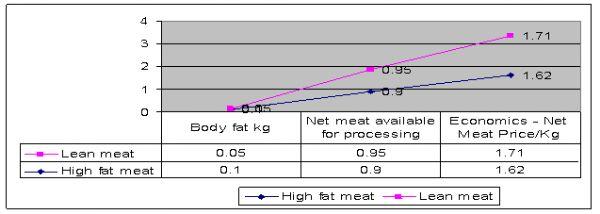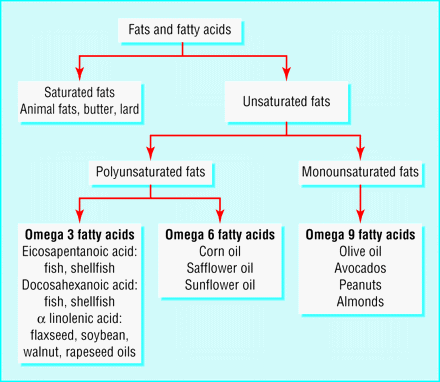Lean Meat Efficiency
Lean Meat Efficiency in Broiler
Published: December 22, 2011
By: Dr. Ramamoorthy. D
Over the last decades, modern broiler industry was focused on achieving optimum performance to reduce the cost involved in producing poultry meat and hence emphasized on
- Genetic selection or modification
- High energy feed
It has been proved the target benefits of optimum performance to a greater extend. However, the major issue associated with this is increasing fatness of broiler.
Lean meat Economics

(Price per kg meat mentioned as 1.8 which, is hypothetical and in USD/Kg)
Modern broilers contain minimum 100 g fat per kg body weight, (10%) which is physiologically inessential and economically of a great loss with today´s burning issue of
- High feed cost and
- Increasing trend in eating habits of processed chicken
Body fat deposition
In general, body fat deposition may be considered as the netresult of the
- Balance among dietary absorbed fat,
- Endogenousfat synthesis (lipogenesis)
- Fat catabolism via ß-oxidation(lipolysis).
Thus lowering body fat deposition can be possible either by increasing fatcatabolism or diminishing endogenous fatty acid synthesis orboth processes.
Fat measuring formula in broiler
The following formula is used for the evaluation of fat deposition in the bird´s body.
Fat content % = [(Initial weight - Final weight)/ final weight)] x 100
Initial weight = Whole meat weight with bone. Final weight = after slaughtering with bone
Fat deposition in broiler - Disadvantages:
It depresses feed efficiency (many studies have proved the sluggish moment of the body due to excess fat deposition)
Abdominal fat is removed by evisceration, thus decreasing processing yield
Nutritional manipulations taken to counter- excessive body fatness include
- Feed Alteration - Changing protein to energy ratio
- Balancing the addition of individual amino acids like DLM and Lysiene
Although one or all of these measures have yielded favorable results to some extends their practical use has been limited due to high price and availability.
Lean meat efficiency the great economical solution in today´s broiler
This presentation will highlight the effect of some of the low cost ingredients that can reduce the fat deposition on the body composition of broiler chickens and can improve the lean tissue deposition in broiler to ensure the maximum economical benefits with least efforts
CHROMIUM
Studies have proved that insulin secretion can be well influenced by dietary trace minerals and Chromium (Cr) has shown to be involved in normal glucose metabolism and is necessary for optimal insulin function which can lead to improve the "insulin response of tissues"and lead to the desirable factors of decreased levels of circulating insulin thus lower body fat percentage, higher lean body mass and decreased mortality rate due to fat deposition issues
Studies have proved addition or supplementation of organic chromium in the diet will improve the sensitivity of skeletal muscle to insulin with the significant difference in both carcass composition and feed utilization.
Also it is known that chromium can minimize the dietary and environmental stress (including temperature, humidity and pathogens) hence Chromium supplementation can improve the performance of stressed birds which, is very common in modern broilers.
Chromium supplementation - Organic Chromium
Only trivalent chromium Cr (III) is biologically active. Metallic chromium cannot be absorbed and Cr (IV) is toxic. Adequate absorption of chromium occurs only when it is associated with a specific organic molecule such as chromium tripicolinate (CrPic) or as high-chromium yeast. The above form of organic chromium can be included in the broiler diet @ 0.5 ppm level as maximum to achieve the desired results.
Cr (III) exerts its physiological effects through its presence in the multiunit complex, the Glucose Tolerance Factor (GTF). Though the mechanism of action of chromium on glucose tolerance and the insulin sensitivity of cells remains unclear; the results are known that chromium positively effect protein synthesis hence chromium supplementation increases protein deposition and also chromium may have a regulatory role in the maintenance of normal beta-cell glucose sensitivity.
Fatty acids
Certain fatty acids play important role in developing lean meat efficiency

LONG CHAIN FATTY ACIDS
Many studies have proved the benefits of long chain polyunsaturated fatty acids on lean tissue deposition. Fish oil is rich in such long chain fatty acids like Omega-3 fatty acids and safflower oil or cakes and lard are rich in linoleic acid.
Fish oil
Omega-3 fatty acids
Fish oil is rich in Omega-3 fatty acids named as docasahexaenoic acid (DHA) and eicosapentanoic acids (EPA) that reduce fat deposition by reducing the circulating - very low density-lipoprotein (VLDL) levels in the blood.
Fish oil rich in n-3 fatty acids reduce the catabolic response induced by immune stimulation and effectively may promote growth. Omega-3 fatty acids also reduce the very low density lipoprotein (VLDL) levels in blood, acting to lower the circulating free low density lipoprotein (LDL) concentration. Omega-3 fatty acids lower the blood levels of free LDLs (which are normally delivered to tissues for fat storage or is deposited directly in the arteries) and reduce the rate of triglyceride synthesis in the liver.
On theory grower or chick diets fortified with fish oils may effectively improve the optimum growth of visceral organs during grower period and result in optimum performance in the finisher with reduced body fat deposition especially breast fat.
A combination of preserving agents and antioxidants may be used to increase the shelf life of fish oil to avoid the free radicals formation.
POLYUNSATURATED FATTY ACIDS - PUFA
A high percentage of polyunsaturated fatty acid (PUFA) content in the diet inhibits lipogenesis and depresses fat deposition in broilers.
Some long chain PUFAs, including linoleic acid is generally converted to arachiodonic acid, a long chain PUFA, which is a precursor for the eicosanoids which are local messenger molecules, which regulate the protein synthesis and degradation.
Beef Tallow - Rich in Conjugated Linoleic Acid - CLA
The major sources of Conjugated Linoleic Acid (CLA) are animal products especially beef tallow around 2.6% of its fat as CLA.
CLA can improve feed efficiency and improves the skeletal muscle mass possibly through its effects on prostaglandin synthesis. CLA can function as below effectively
- Improvement of insulin sensitivity cells
- Inhibition of fat formation - reduction of body fat
- Enhancement of immune system
CLA has the ability to decrease the catabolic response generated by the immune system without altering the normal immune systems functioning. Reducing this response minimizes the breakdown of skeletal muscle and thus improves feed conversion and enhances lean growth.
Thus, CLA at a level of 0.5% of broiler diet would reduce body fat and help increasing lean tissue deposition.
BRANCHED CHAIN AMINO ACIDS (BCAA)
BCAA´s - leucine, isolecuine and Valine have been proved to be effective in promoting protein synthesis and skeletal muscle growth.
Many studies have shown effects of BCAA on protein synthesis and reduce protein degradation by increasing the proportion of polysomes. BCAA especailly isoleucine plays an important role in hemoglobin synthesis, regulation of blood sugar & energy levels. Leucine is another essential branched-chain amino acid important for hemoglobin formation. Valine is also other branched-chain essential amino acid that promotes muscle growth and tissue repair
In general studies have proved that BCAA can regulate the rate of protein turnover in skeletal and heart muscles. In heart tissue, BCAA has been demonstrated to accelerate protein synthesis and inhibit protein degradation.
Betaine - Effective methyl donor
Though inclusion of choline and other essential amino acids like DL-M as feed additives have proved practically both as hepatic enzymes stimulant as well the effective utilization of fat into digestible energy by increasing the skeletal muscle growth the modern studies of betaine inclusion in poultry diet have proved much more effective than the others.
Betaine is a multi-functional amino acid feed additive. It can regulate the energy level in the poultry by making a better distribution of acetone body fat by promoting the fat metabolism.
Studies have proved betaine inclusion in broiler feed either directly or as the replacement of DL - Methionine @ 1: 3 ratio or 0.3 kg/ton of feed respectively can increase breast meat yield and carcass yield as total. Thus it can improve the quantity and quality of pectoral muscle of meat-chicken.
Biotin - Vitamin H
Among the role of vitamins in poultry biotin (Vitamin H) has very great role in poultry economics because it enhances feather growth means prevents energy loss from protecting the bird from extreme weather change; plays important role in fat metabolism by ensuring the activities of two biotin dependant enzymes
- Pyruvate carboxylase - PC
- Acetyl-CoA carboxylase - ACAC

Pyruvate carboxylase a biotin-dependent enzyme catalyses the ATP-dependent carboxylation of pyruvate to oxaloacetate. Also, PC plays a crucial role in gluconeogenesis and lipogenesis, in the biosynthesis of neurotransmitter substances, and in glucose-induced insulin secretion by pancreatic islets.
ACAC plays important role in muscle cells, to regulate the fat mechanism. When ACAC is active, the product, malonyl-CoA is produced and inhibit the transfer of the fatty acyl group from acyl CoA to carnitine (major energy source for muscles) with enzyme carnitine acyltransferase, which inhibits the beta-oxidation of the fatty acid in mitochondria. Thus prevents fat deposition majorly in liver and kidney. Hence, biotin has the major role in lean meat depostion by preventing fat depostion.
Hence, inclusion of biotin as minimum 200 mcg per kg feed will certainly ensure the economical benefits in broiler.
Natural and or herbal extracts
There are many natural or herbal extracts can be used to stimulate the hepatic cell functions to secrete hepatic enzymes play the role in inhibiting fat deposition like Phylanthus niruri, Phylanthus amarus, silymarin and Garcinia Combination´s. The functional results of these herbal extracts have been well proved practically. (Invitro studies)
Among those the Garcinia has been standardized and proved to contain hydroxycitric acid significantly. Research has demonstrated that hydroxycitric acid (HCA) decreases appetite, inhibits the conversion of excess carbohydrates into fat, and increases stores of the body´s energy fuel - glycogen. Hence, the addition can play the major role in lean meat deposition.
The dosage of the natural or herbal extracts can be followed as per the label or product claim because mostly they are used in the combinations to be effective.
Summary
Its high time that we should give a serious thought on converting the extra fat into metabolic energy to convert or deposit into lean tissues despite of throwing it as a greater economical waste. Such thoughts can improve our broiler economics to a greater extend.
References:
Nutrition of the chicken 4th edition - Steven Leeson & John D Summers.
Wikipedia, the free online encyclopedia
Related topics
Authors:
Recommend
Comment
Share
Suguna Group
5 de enero de 2012
Dear Sir
The article gives good insight in the lean meat production in broiler. Regarding Chromium, we know that trivalent chromium is biologically active and the metallic chromium will not be absorbed and CR (IV) is toxic.
Can you please provide more details as what will be the negaive effect of chromium which is added through feed through leather meal inclusion as adulteration in animal protien sources. I hope the chromium does not occur naturally in MBM or fishmeal and if present, could you please help me to understand the maximum chromium level in animal protein sources?
Regards
Balamurugan,R.
Recommend
Reply

Would you like to discuss another topic? Create a new post to engage with experts in the community.








.jpg&w=3840&q=75)